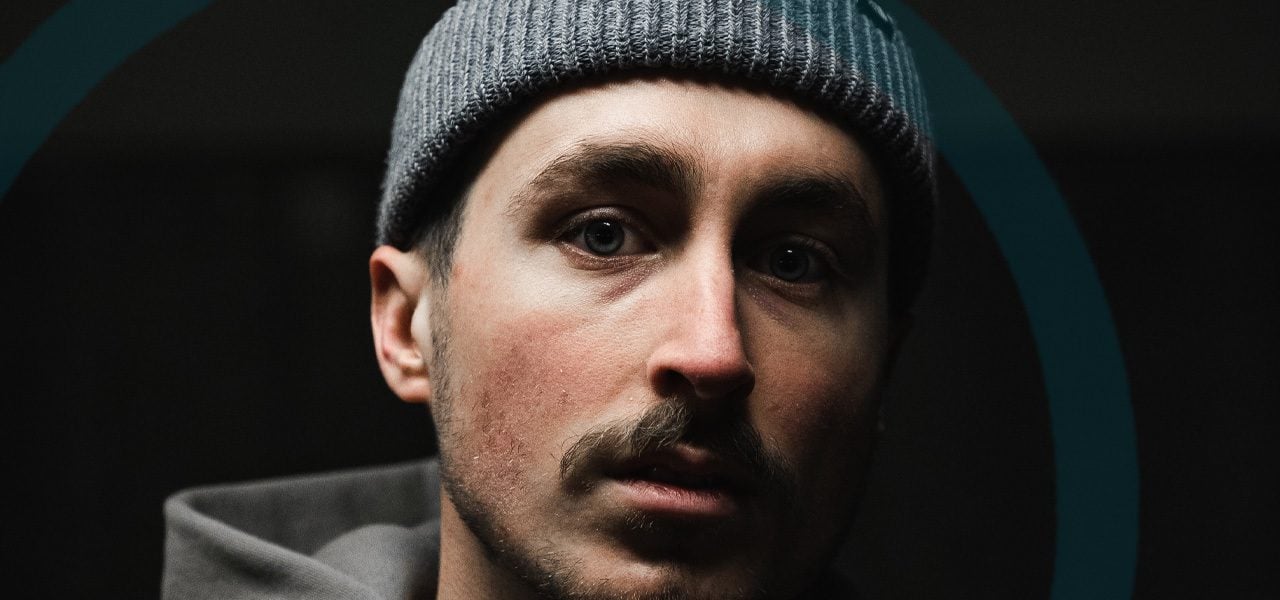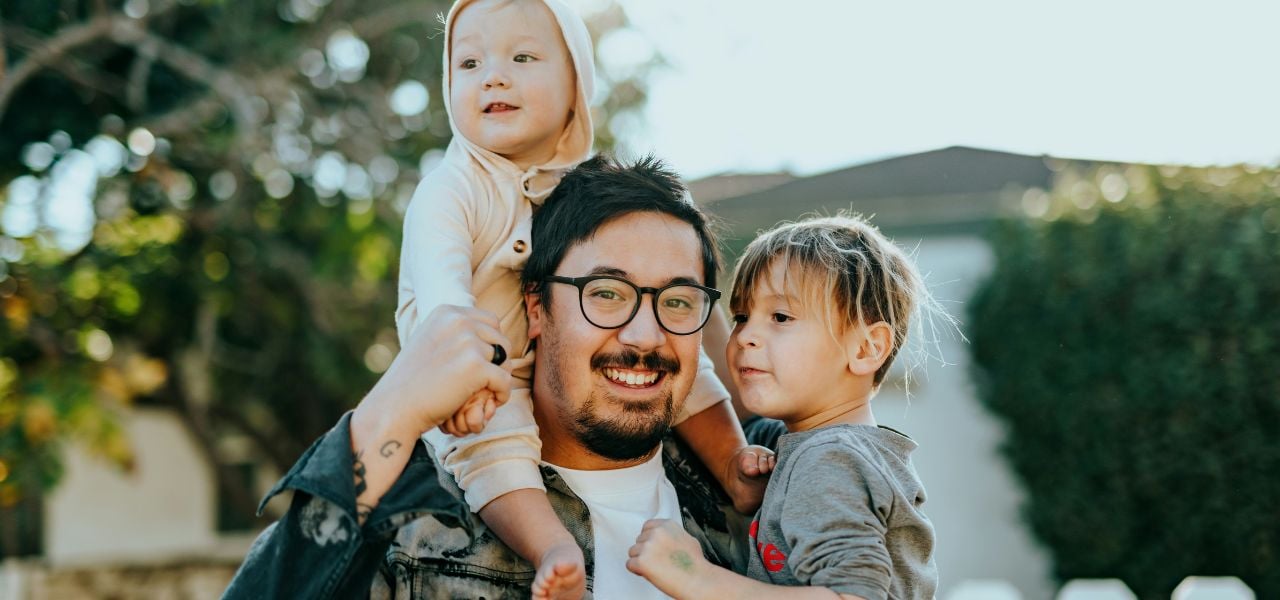By Jeff Vircoe
Find out how Edgewood alum Amber K. has used her own recovery as a chance to help other women find new lives.
It has been over six years and sometimes Amber is still amazed. Amazed she is sober. Amazed what her life is like today. Amazed she is even alive.
At 41, Amber runs a sober living house in Nanaimo, B.C., a safe sanctuary home to eight beds filled with eight women aching to find freedom from substance abuse.
Amber is the manager, while her sister owns the house. The two are a family who have never been closer, ever since Amber found recovery. And right in the middle of this success story is EHN Edgewood Nanaimo.
It was not always that way. Six years ago, Amber was in serious trouble – with meth amphetamine, with the law, and with the folks who buy and supply drugs.
It never should have gotten that bad.
Early Life Showed Good Grades and Promise
Amber was a good kid, got great marks in middle school, seemed to be handling herself as an adolescent in rural Alberta with no real issues.
“I was a pretty good student,” she says. “I was always very good at math. In exams, I would always take it as a challenge how high a mark I could get. So, in Grade 9, I got 100%. I was deemed in the top three percent of all Alberta Grade 9 kids. That definitely stroked my ego.”
However, things went south at age 14, when she was sexually abused. She coped by finding ways to compartmentalize the pain.
Coping with Trauma Through Disassociation
“I started to learn how to disassociate. That would take hours and days out of my realm for me,” she says. “I didn’t want to be present. So, there were certain things I would do. I developed a sense of Obsessive-Compulsive Disorder (OCD). I would start to organize things. I would take my clothing out of my closet and organize them in rainbow order. Red, yellow, orange, green, blue, purple…”
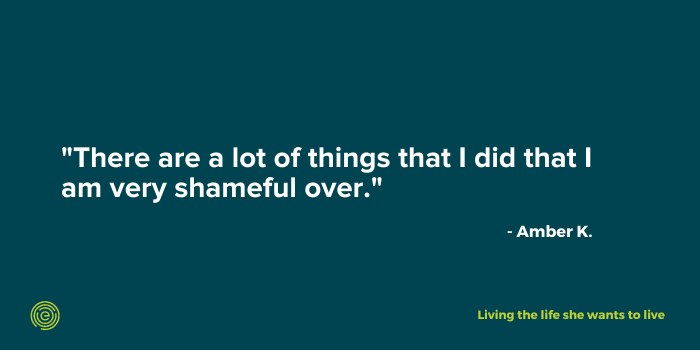
At the time, she began a love affair with alternative music – Nirvana, Bush, Silverchair. More disassociation opportunities arose.
“I would take this big binder of CDs and throw them all over my floor and put them all back in alphabetical order. I would just mind numb. I just didn’t want to be present. I didn’t want to be a part of the house. If it wasn’t for my sister, I don’t think I would ever be home. I think I would have always been over at friends’ houses.”
Hours and hours and days would be wasted doing these activities, she recalls. Meanwhile she started to write some “really dark poetry. A lot of suicidal ideations. A lot of harming myself, harming other people. I never did harm myself, but I would write about it.”
Cannabis and Alcohol Added to the Mix
By 17, she added older boys, alcohol, and cannabis into the mix of angst. She graduated high school and moved to the big city of Calgary.
“I was working at Tim Horton’s. It was my first job in Calgary, and I loved it. But I would spend my whole paycheque on alcohol and then ask my dad to pay my rent and my bills. For many years, that is what he did.”
Those many years ended up in the progressive slide into addiction. She attended college to try to be a chef, always her dream. But along the way, the addictive behaviours grew. First alcohol, then diet pills, then pot.
“I would get diet pills that had ephedrine in it, to be able to stay up and be able to study. Or stay up because I had breakfast cooking the next morning. But still drinking. And hanging more around people that were smoking weed. When I started smoking weed, that was the switch for me.”
Stimulants Lead to Spiral into Addiction Lifestyle
Speaking about an older boyfriend, she says, “We were dating for maybe three months when we went out to a convenience store to get a pack of cigarettes. He wanted to pay for it. When he pulled out his debit card, a little baggie of cocaine fell out.”
So, suddenly, cocaine was in. Weekend use became daily use, and then it became a business. Dealing, some for you, some for us. Guns. Gangs. The escalation was complete when meth came in.
“We were probably doing about a half ounce of coke a day. Then we switched to meth. And when we switched to meth, that is when everything started going south very quickly.”
Amber’s crash included police and court rooms. She reached out to her sister and talked her into a series of rescues followed by broken promises. Move here. Go there. Lies, lies, and more lies.
“It had gotten to the point where there are a lot of things that I did that I am very shameful over. I have physically hurt people. Up until this past year, it was like what kind of person does that? I am a shitty person. It was survival. It was doing the things I needed to do. Using for me, it got to the point where it was if I don’t use and I fall asleep, I don’t know who is coming through that door.”
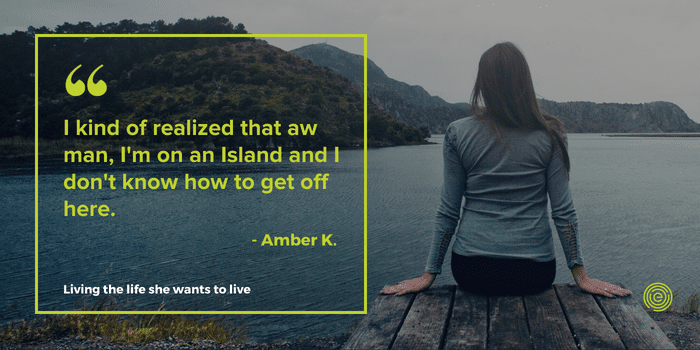
Over Christmas 2016, her father offered her a gift that would change her life. He would cover the bill if Amber agreed to go to treatment. Edgewood was selected and arrangements were made. After a series of missed flights, she arrived in Nanaimo the first week of January.
A Safe Place to Begin Treatment
The blur of the first couple of weeks in treatment still makes her smile.
“Once I came out of that fog, I realized where I was. When I had chosen Edgewood, I didn’t know that Nanaimo was on the Island. I had no idea. I kind of realized that aw man, I’m on an Island and I don’t know how to get off here. I remember morning groups just sitting and being like, I don’t want to be here. Falling asleep in lectures. Just not caring.”
Executive Director Joel Hughes impacted Amber’s treatment giving a talk one morning.
“I remember a lecture, and Joel saying, ‘Give it a shot and if recovery isn’t for you, your misery is always refundable.’ And I thought, okay. I started talking in morning group that day.”
In the end, Amber would spend four and a half months at Edgewood, in the Core Program, followed by Extended Care. She has had many “ah hah!” moments along the way, as she began to fight for her life against a disease which seemingly wants those who endure it dead.
“The toughest moments definitely relate to Step Four [Taking Personal Inventory]. Doing the work of the fourth totally rocked my world, flipped things upside down. Just the realizations. I did my Step Five with Seth, which was really cool – he brought me in and in a way, he sent me out.”
She talks about her time at Edgewood with great reverence, six years later. She knows she paid a high cost in pain to get to recovery, but in the end, she knows it was worth it.
Building Her Own Therapeutic Community
When she got out, she chose to stay in Nanaimo, where her new recovery community was. Connections were made and deep bonds were forming. She completed a year of Aftercare sessions and attended meetings. Meanwhile there were court cases to go through. A four-year career change into legitimate retail at a cosmetics store. She even worked at Edgewood as a support staffer and in the admissions department for a spell.
One day her sister suggested a sober living opportunity for women. Her sister purchased the house, and Amber began working as the live-in manager. A natural fit for someone who is serious about her recovery, modeling resilience and courage to other women. Helping others has become a key component of her recovery.
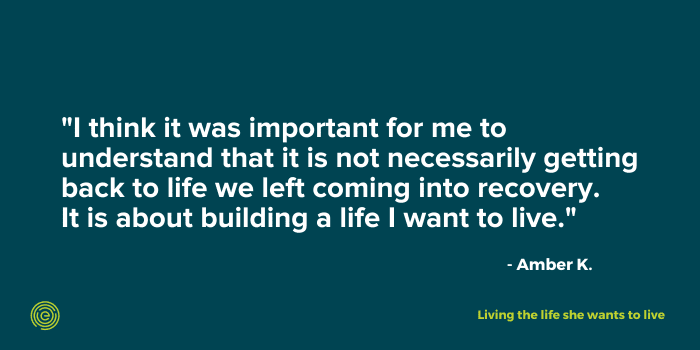
“Part of what the program at the house is I get the women to four meetings. But I also started doing work in the Adult Children of Alcoholics (ACOA) program. Between Narcotics Anonymous steps, AA steps, the Women’s Way Through the 12 Steps, I have done six sets of steps.”
Six Years Later Amber is Still On the Path
Today, Amber is deep into her recovery. She has been in counseling post-treatment, including trauma counseling. Her former Edgewood inpatient counselor, Ryan Tomkins, has a practice in Nanaimo and they have maintained a therapeutic alliance which Amber says is a god send.
“I don’t know how much longer I could have kept going without doing the trauma work. It has been so crucial. Everybody around me has seen this shift in me. Before I was very mistrusting. Closed off. Now I am a lot more vulnerable with people.”
Amber is one of those alumni from Edgewood who seized the opportunity to change her life. Not everybody does. She knows how close she came to oblivion, and she knows how she found her way out. She does not regret the past, nor wish to shut the door on it, one of the key promises of the fellowships that are helping to keep her headed in the right direction.
“It was absolutely insane. But I see these things as crucial. They needed to happen. And there was also somewhere along the line, I chose to live. I knew I couldn’t go back. I always felt super safe at Edgewood.”
She closes with a sense of purpose.
Building a Life Worth Living
“When I was in really early recovery, I was going to the meetings and listening to the shares. I remember somebody sharing around the topic of gratitude how he was grateful that he had got his life back. I am sitting with this immense anxiety because I am thinking, I don’t want anything from my life back! I don’t want that. And if that is what you are saying I am going to get, I don’t want to be here.
“What I have learned now is that I have built a life that I want to live. I have literally cut ties with almost everybody from my past. My family is boundaried up. I think it was important for me to understand that it is not necessarily getting back a life we left coming into recovery. It is about building a life I want to live.”
Beginning a Journey of Recovery Starts Here
If you would like to find out more about our treatment options for you or someone you love, fill out this form and our admissions team will get in touch with you soon.

